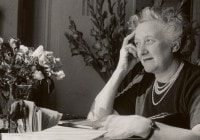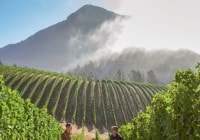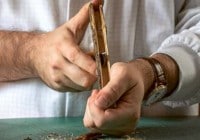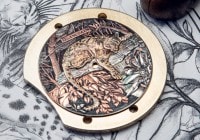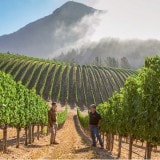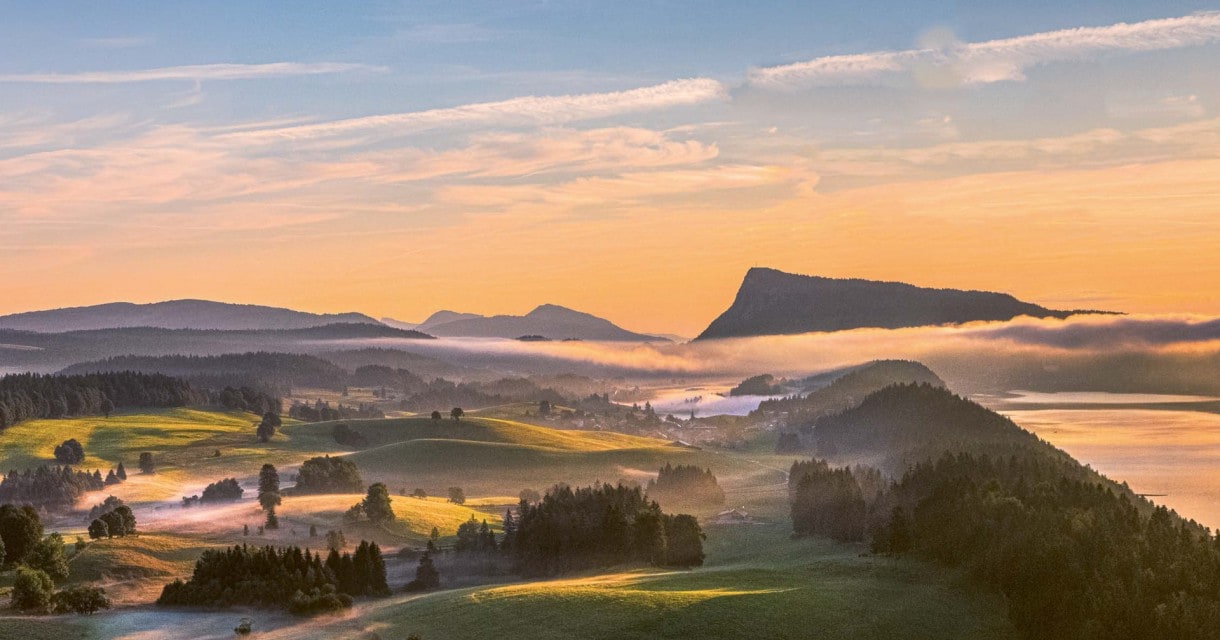
Search in Issues
Chapters
List of parts
Chapter 4
Peter Michael WINERY
British ownership, California wines, and French influences.
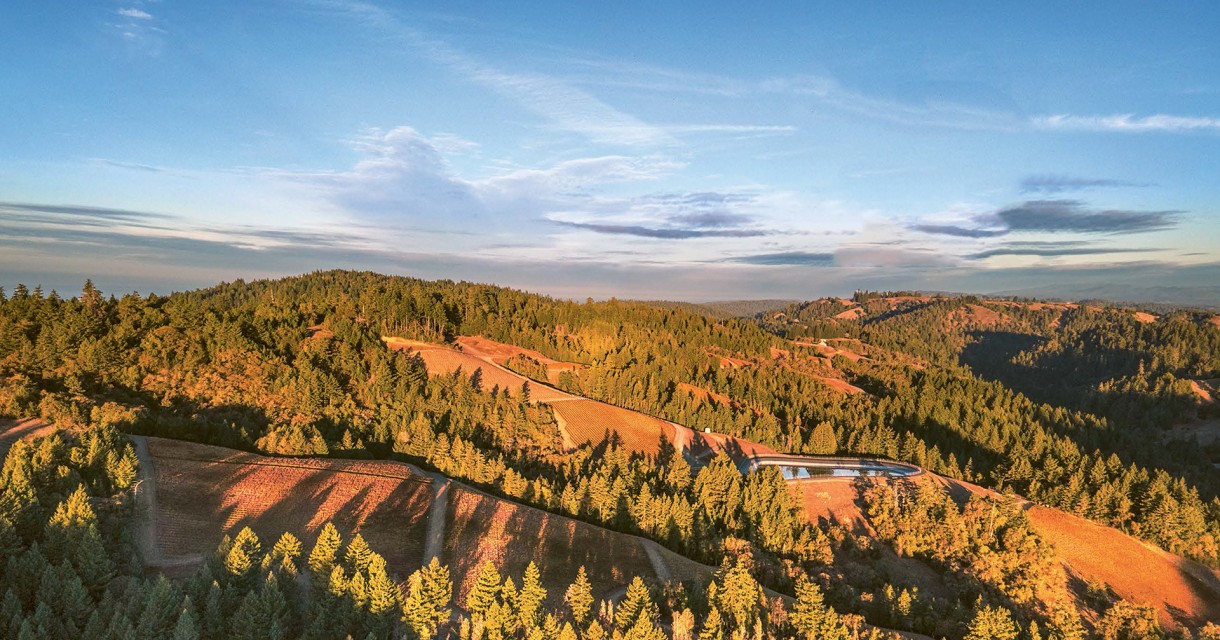
Is this really how a wine tasting is supposed to go? Sir Peter Michael’s son, Paul, had his baptism in the family wine business, now in its fourth decade, from day one so to speak.Trudging up steep slopes soaring along the flanks of Mount St. Helena which dominates the landscape north of California’s famed Napa Valley, Paul worked side by side with the crews on the gritty backbreaking tasks never celebrated in romantic odes to wine but central if one actually wants to produce it: removing stones; clearing trees, stumps and brush; planting vines; installing irrigation. So it was beyond question that when the first release, a 1987 Chardonnay, left the Peter Michael cellars, a bottle would be expressed to Paul, then enrolled in Switzerland’s prestigious École Hôtelière de Lausanne (Lausanne Hotel Management School). How better to celebrate this debut than to organize a tasting with the school’s professor of oenology?
What followed was a slashing wound. Far from eager to taste the California wine being offered, the professor’s advice was to steer away, observing: “The important wine you need to know about does not come from California; it comes from France and, of course, a little from Switzerland”. Evidently, news of the Judgment of Paris had escaped his attention. This was, of course, the late Steven Spurrier’s 1976 tasting pitting California wines from Napa against the best that France had to offer: first growth Bordeaux and Grand Cru white Burgundies. Judged by French restaurateurs and sommeliers in a blind tasting (the identities of the wines hidden), a Chardonnay made by Mike Grgich at Chateau Montelena and a Cabernet Sauvignon made by Warren Winiarski at Stags Leap sent shock waves around the world with their triumph over their French rivals.
Hobbled by arthritic notions of important wine geography, that Lausanne professor certainly locked himself in a comfort zone of nano dimensions. Imagine trying to stretch his imagination to embrace the expanse of what Sir Peter Michael’s winery represents. It is a stitching together of ownership by a British family, vineyards located in California, and inspiration drawn from French Burgundies and Bordeaux. The record of the ensuing decades teaches never to prejudge or to apply blinders. The Peter Michael scorecard: seven wines placed in the Wine Spectator’s list of Top 100 wines of the world, four in the top 10, eleven awarded the rarely given lofty score of 100 points from the Wine Advocate and numerous others with 99 points. As for the École Hôtelière, a dramatic reversal. As its graduates fan out to hospitality businesses around the world, the wine curriculum now fully reflects that globalization. And as the coda to that “tasting that never was” of the 1987 Chardonnay, the school’s tasting room now bears the Peter Michael Winery name.
Yet Sir Peter did not come to California to make wine. He is an engineer by training and was drawn to Silicon Valley in the 1970s to found an electronics company focused on generating special effects for television. The climate and the beauty of the countryside surrounding San Francisco seduced him, planting the notion of owning property somewhere near the Bay Area. That it should be a winery, of all things, grew out of a failed bottle of French wine. Dining in the San Francisco Fairmont Hotel restaurant, an ordered bottle of French Burgundy disappointed, prompting Sir Peter to ask the sommelier to recommend something local. The sommelier selected a bottle of Chateau Montelena Chardonnay, the winery that upended the French in 1976. It was a revelation. That night Sir Peter vowed that the property he would buy would be a vineyard.
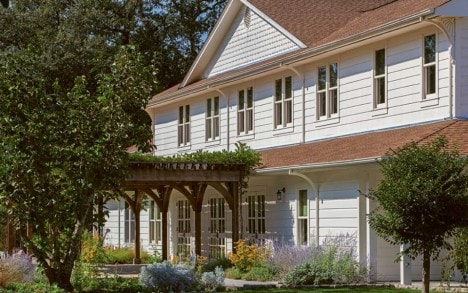
The winery pays homage to 1800’s California architecture.
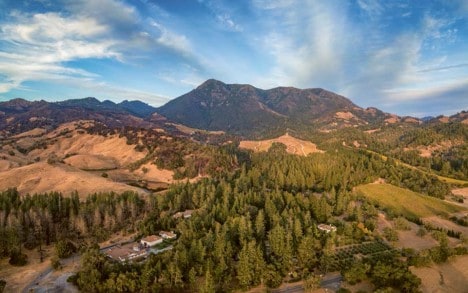
Mt. St. Helena towers over the Knights Valley vineyards.
Finding the land was not easy. Sir Peter and his family surveyed some 40 different sites in the Napa Valley and its surroundings. Their search eventually brought them to today’s location in Knights Valley located to the north and west of the heart of Napa Valley. What greeted them on their inspection was a dusty cattle ranch with what could be charitably called a rather neglected Victorian dwelling. But what the family also discovered was a breathtaking pastoral setting, slopes with volcanic soil ideal for growing grapes and year-round sources of water with both a creek and small lake.The decision to purchase was made at once. To his European sensibilities, however, what he saw seemed upside down. On the hillsides he saw no vineyards: the only plantings were on the valley floor. The hillsides were given over to the cows as pastureland. In France it would, of course, be the opposite with vines on the hills, other agriculture and animals on the flat land. After the purchase, months were devoted to scouring the 800-acre parcel to define the locations of the best soils for vineyards, all of which were found at altitudes above 900 feet, some of which were not only well above that height but also upon rocky slopes with pitches rivaling those of Côte-Rôtie in the northern Rhone region of France. To the locals who followed Napa convention of less laborintensive valley planting, the Michaels were seen as “Mad Englishmen” toiling on the hillsides.
The early ambitions were modest, coyly retiring in fact. Since these Knights Valley hillsides were not then known for producing world-class wine, the hopes were that a few bottles of claret could be made that would not embarrass the family at dinners with their English friends. Helen Turley was retained as the first wine maker and initial plantings placed upon today’s Les Pavots vineyard. Like all of Peter Michael vineyards, Les Pavots bears a French name – a nod to French traditions – and was conceived to be a Bordeaux blend of Cabernet Sauvignon, Cabernet Franc, Merlot and Petit Verdot. That decision to feature a Bordeaux blend was bold as it ran against California convention during the 1980s. At the time, the most prestigious California reds were overwhelmingly Cabernet Sauvignons. Indeed, California labeling laws prohibited selling wines as Cabernets unless the percentage was above 75%. This rule placed Bordeaux blends, customarily falling below that limit and which could only be labeled “red wine”, at a disadvantage in the market, since it was Cabernets that consumers had been “trained” to seek out.
Les Pavots in many ways is the symbol of the estate. “Pavots” are poppies and when the family first saw the land it was covered with them. Being in California they were of the golden variety, in contrast with the European species that the Michaels knew best which are red in color. The logo for all the Peter Michael wines features a red poppy stylized to call to mind as well an English hunting horn.
The first plantings may have been the Bordeaux reds of Les Pavots, but the Chardonnays soon joined. Many in the wine world have had doubts about the wisdom of trying to produce Bordeaux type wines and Burgundy wines, such as Chardonnay, at the same time.This was the view offered by Jean-Guillaume Prats, the CEO of the renowned Domaines Baron de Rothschild (Lafite) and the former CEO of Château Cos d’Estournel in Bordeaux. During a lunch with the family, he counseled that: “the thing is either you are Bordeaux or Burgundy but you can’t be both”. Sidelight: that advice may have reflected beliefs at the time, but today several owners straddle the two regions. The Chardonnay vineyards lie above Les Pavots, extending up to an elevation of 2000 feet. The higher elevation exposes them to cooling sea breezes, essential to achieving elegance and balance in the otherwise warm climate of California.
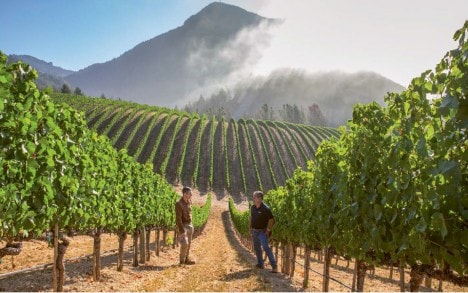
Winemaker Robert Fiore at left with vineyard manager Javier Aviña at right.

The RANGE OF WINES is broad: Bordeaux blend red, Chardonnay, Pinot Noir, Cabernet Sauvignon, Sauvignon Blanc/Semillon blend.
The soils on the upper slopes also offer more compressed volcanic ash, ideal for Chardonnay, giving the wines a natural acidity for freshness. Currently there are four distinct vineyards planted in Chardonnay: La Carrière (the quarry) which is the steepest with a 46-degree slope on one of its parcels; Belle Côte (the beautiful slope); Mon Plaisir (my pleasure); and Ma Belle-Fille (my daughter-in-law, named after Paul’s wife, Emily, Sir Peter quipping that many brownie points were earned by appending that name). As the name suggests, La Carrière boasts the rockiest soil, lending its bottlings the most pronounced mineral notes. Belle Côte has a deeper soil giving it added richness and exoticism. Mon Plaisir is planted with a classic California Chardonnay clone known as Old Wente; the other vineyards are planted with a mix of historic California clones and the French Dijon clone. The largest and the highest in elevation of the four is Ma Belle-Fille. Its elevation gives it an extra dimension of complexity. For the future, a new parcel has been cleared on the upper slopes. Both its wines and name are waiting in the wings, as for the moment it is simply called “Vineyard No. 9”.
With this diversity of elevations and undulating exposures, Peter Michael adheres to the French practice of harvesting by block. Each of these vineyards is subdivided into blocks which take into account the different degrees of ripeness of the fruit during the harvest period.
The family’s affinity for Burgundy is expressed further in its Seaview plantings. Seaview is found in the hills bordering on the Pacific, a 90-minute drive to the west in the Fort Ross-Seaview Sonoma Coast AVA. This is Peter Michael’s site for Pinot Noir. Although the parcel comprises some 400 acres, plantings are confined to a mere 29 acres. As with the Knights Valley vineyards, Seaview’s are found high up east-facing slopes, thus limiting the effects of ocean winds, providing a degree of shelter from winter storms, and vitally important, placing the vines above the fog line. In many ways the micro-climate is that of the Gualala river which lies at the base of the hills. As with the Chardonnays there are distinct cuvees: Ma Danseuse (my dancer as Sir Peter met his wife in dancing school); Le Caprice (named after the capricious nature of pinot noir); and Clos du Ciel (the sky). Ma Danseuse is the most elegant of the three; Le Caprice offers riper fruit and denser texture; Clos du Ciel, found in the warmest section of the estate, is the most complex and age-worthy.
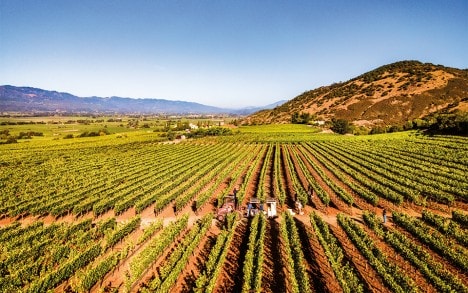
Peter Michael’s Oakville Au Paradis Cabernet Sauvignon vineyard.
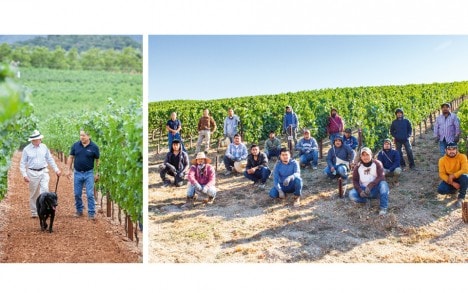
The PINOT NOIR cuvees are grown on the California coast.
There are several other noteworthy bottlings. From Knights Valley, L’Apres-Midi (afternoon). This is found on a parcel just below Le Pavots and is a classic white Bordeaux blend of Sauvignon Blanc and Semillon. Point Rouge (red dot) represents the rarest of the Chardonnay offerings. It is a blend of the finest barrels from Knights Valley. Its name refers to red dots that are placed upon the barrels that are judged to be the best. Another small-blend Chardonnay, Cuvée Indigène (indigenous cuvée), is a blend of Old Wente clones from select estate vineyards. There is one offering that originates in the heart of the Napa Valley from Peter Michael’s vineyard on the eastern hills above the famed Oakville bench. Bearing the Au Paradis (in paradise) name, this is a small-production Cabernet Sauvignon.
Taken together, the Peter Michael estates comprise over 1,100 acres. Yet only 200 acres have been planted. The remaining acreage has been left as wildlife corridors. Testament to the family’s commitment to be worthy stewards of the land, all the estates have been officially certified “Fish Friendly Farming” and “California Sustainable”.
Managing vineyards this dispersed and planted in such a wide range of varietals is an enormous undertaking. For more than three decades Sir Peter has entrusted the care of his vines to Javier Aviña. He has been called upon to do more than the traditional planting, plowing, pruning, irrigating and other core tasks of vineyard care. Aviña keenly observed the dangers of wildfires that have in years past ravaged sections of the hills bordering the Napa Valley. Prescient, he convinced the family that it must invest in aggressive removal of dead trees, overgrown dry brush, and other wildfire fuels which surrounded the Knights Valley property. His foresight proved its merits in 2020 when a virulent wildfire propelled by fierce winds broke out in the region. Areas not as wisely cleared were destroyed; all the vineyards and buildings on the estate escaped unharmed. His current challenge: rationing irrigation water from reservoirs on the slopes badly depleted by two years of drought.
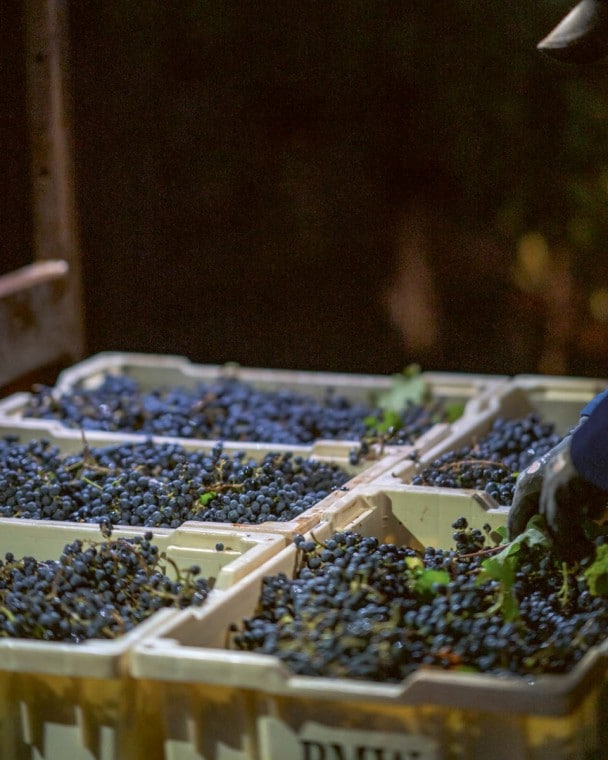
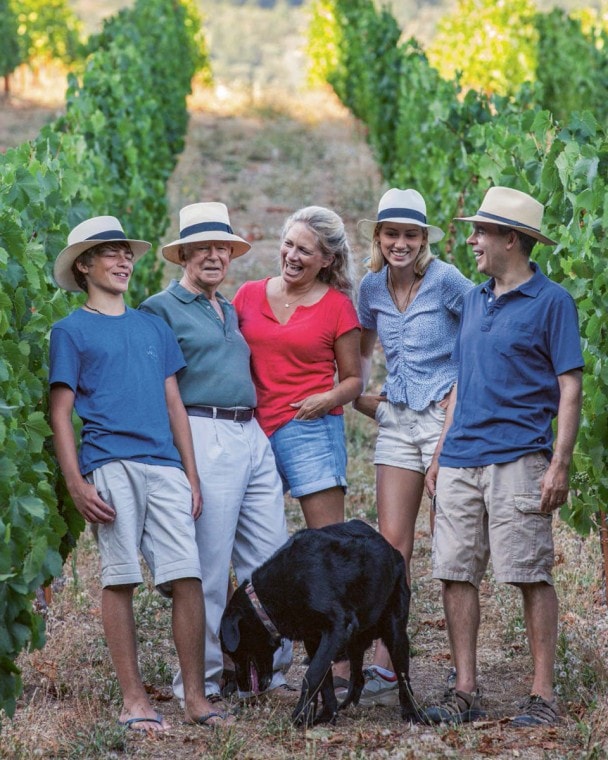
Sir Peter Michael’s family. Left to right, grandson Mylo; Sir Peter; daughter-in-law, Emily; granddaughter, Anna; son, Paul. The dog, Tucker.
The WINEMAKING PHILOSOPHY from the outset has emphasized COMPLEXITY, NUANCE and TERROIR .
Equally vital has been the engagement of the estate’s winemakers. The succession represents a who’s who of California winemaking stars. Working with their first winemaker, Helen Turley, the family established the style that has been carried forward for nearly four decades. There has been a tendency in some quarters in Napa to emphasize blockbuster power over refinement and complexity. The family inclined away from the punch-in-the-nose school of superman wines, insisting on a Burgundian approach favoring complexity, nuance and a clear expression of the particularities of the vineyard, a property that the French call “terroir”. She was followed by Mark Aubert, who after several years went on to found his own, now acclaimed, winery in Napa. Two French winemakers followed Aubert’s departure, Luc and Nicolas Morlet, who remain close to Peter Michael as consultants. The current winemaker is Robert Fiore. A good part of his educational background points away from winemaking as his degrees were in geology and geo-physics. Those degrees were followed by the pivot toward wine with studies of oenology at UC Davis and most importantly a long sojourn in Burgundy working at Domaine Michel Lafarge in Volnay. That combination has given Fiore a perfect platform for his winemaking. UC Davis enjoys worldwide renown for its advances in all the scientific and technical aspects of winemaking. Burgundy is where the emotion, soul and artistry of winemaking find their finest expression. Fiore is proud to have a foot in each camp. Sir Peter is modest about the toil and mammoth investments over four decades that have placed the family’s offerings at the very pinnacle of California winemaking, preferring to talk instead about the role of luck at critical times. He recounts finding legendary critic Robert Parker at an adjacent table in a Calistoga restaurant. Parker and his wine ratings then ruled the world’s wine markets, anointing winners and shattering reputations. As Sir Peter describes it, he saw both an opportunity of a lifetime and peril as he approached Parker’s table to introduce himself, relieved to find one of the family’s wines already there. After that first meeting Parker included Peter Michael wines in tastings conducted in France with the bottles winning top notes. Another stroke of good fortune was having the wines selected for inclusion at State dinners at the White House.
An anonymous wag once observed that after 50 years of work he became an overnight success. In the case of Peter Michael wines, it has likewise spanned decades. One thing has become clear over this time span: the family’s dedication to their “100 x 100” credo, a 100% commitment to the land for 100 years.
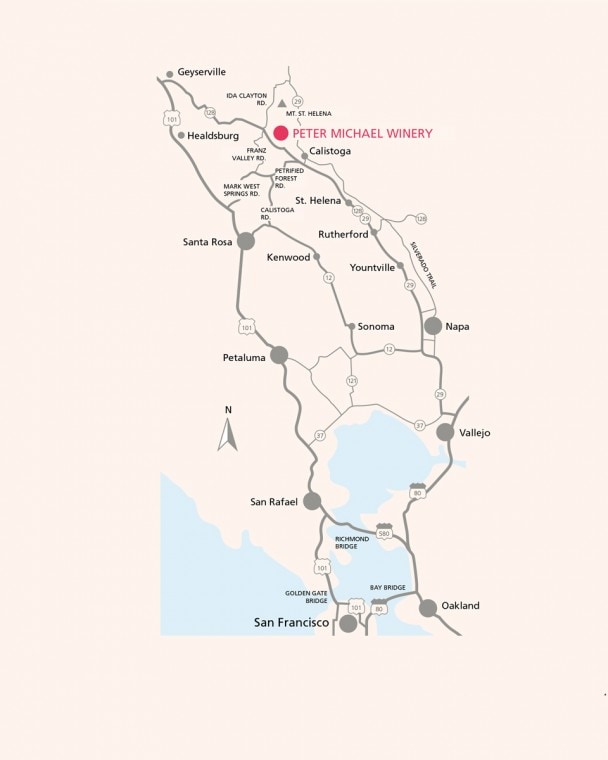
TASTING Notes
All wines tasted from the bottle at the Knights Valley estate in April 2021.
2018 L’APRÈS-MIDI
A blend of 90% Sauvignon Blanc and 10% Semillon. Planted on the lowest section of Les Pavots. 20% new oak barrels. Lovely minerality stitched together with bright pineapple notes.
2017 MA DANSEUSE (PINOT NOIR)
A year with a cool wet spring. Ma Danseuse has the coolest micro-climate of the coastal pinot noirs. Black cherry notes with hints of strawberry jam. Voluptuous texture. 100% destemmed.
2019 LA CARRIÈRE (CHARDONNAY)
A wet winter followed by highly variable temperatures in spring. Fruit set later than normal. A nose offering lime, flowers and minerals. Bright acids in the mouth with a touch of grass which conceals the impressive weight. Butter finish.
2019 MON PLAISIR (CHARDONNAY)
Pretty wine with well-integrated acid and fruit. The style evokes a Puligny of breed. Fruit forward with honeysuckle and flowers.
2019 BELLE CÔTE (CHARDONNAY)
An east-facing slope. The oldest Chardonnay vines from the estate, planted in 1990. Slowest to ripen owing to its eastern exposure. Lychee nut nose. Exotic in the mouth offering delicate pineapple and crème brûlée. Racy.
2019 MA BELLE-FILLE (CHARDONNAY)
The highest elevation Chardonnay vineyard. Notes of orange flower in the nose. Round and weighty on the palate. Richest of the four Chardonnays. All Chardonnays are barrel fermented. Batonnage done bi-weekly. 40-50% new French oak.
2016 LE CAPRICE (PINOT NOIR)
Deep purple color. Fig aspect to the nose. Quite fruit forward with impressive weight.
2016 MA DANSEUSE (PINOT NOIR)
Brighter and also more tannic than Le Caprice. Raspberry bouquet. Firm and structured on the palate.
2016 CLOS DU CIEL (PINOT NOIR)
The highest of the Pinot Noir plantings starting at 1,275 feet and rising to 1,400. Pretty red fruit nose. Wonderfully accessible now. Round and fleshy but the fruit is focused and well-defined. Elegant.
2018 AU PARADIS
From the east side of the Oakville bench at an elevation of 500 feet. 76% Cabernet Sauvignon; 13% Merlot; 11% Petit Verdot. Heavy rain from February through April. Focused nose of cassis followed by plums and licorice on the palate. Very structured and tannic, boding well for the long haul.
2018 LES PAVOTS
68% Cabernet Sauvignon; 19% Cabernet Franc; 10% Merlot; 3% Petit Verdot. A wine offering up abundant ripe plums married with toasty vanilla oak and hints of smoke. Round ripe tannins.
2012 LES PAVOTS
64% Cabernet Sauvignon; 20% Cabernet Franc; 11% Merlot; 5% Petit Verdot. An almost Rhone-like character… blackberries, blueberries, raspberries. Whiffs of cedar and pencil in the nose.
2009 LES PAVOTS
66% Cabernet Sauvignon; 22% Cabernet Franc; 10% Merlot; 2% Petit Verdot. Abundant red fruits and pomegranate with a touch of confiture. Full in the mouth with round fully resolved tannins.
2007 LES PAVOTS
70% Cabernet Sauvignon; 17% Cabernet Franc; 10% Merlot; 3% Petit Verdot. A wine of exceptional breed bringing to mind a First Growth Graves. Nose offering up red fruits and tobacco leading to a velvet, delicate texture in the mouth with wonderfully focused fruit. Power and softness at the same time. Balanced.
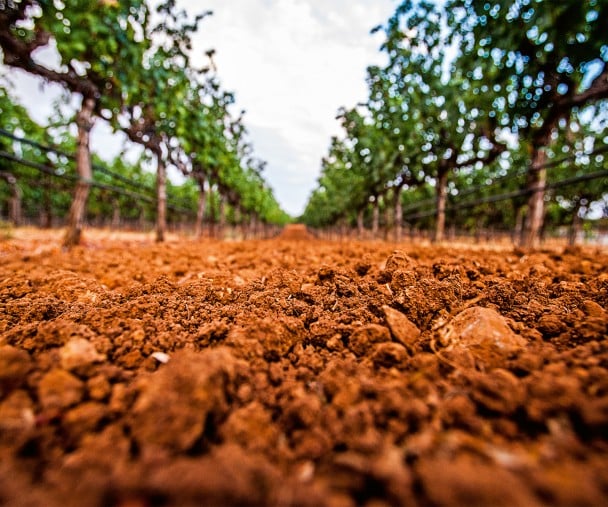
Other issues
Don't miss the latest issue
Sign Up for New Releases


